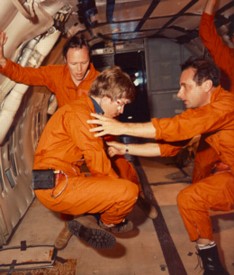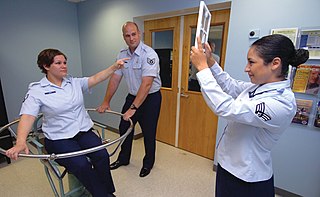Related Research Articles

Motion sickness occurs due to a difference between actual and expected motion. Symptoms commonly include nausea, vomiting, cold sweat, headache, dizziness, tiredness, loss of appetite, and increased salivation. Complications may rarely include dehydration, electrolyte problems, or a lower esophageal tear.
A balance disorder is a disturbance that causes an individual to feel unsteady, for example when standing or walking. It may be accompanied by feelings of giddiness, or wooziness, or having a sensation of movement, spinning, or floating. Balance is the result of several body systems working together: the visual system (eyes), vestibular system (ears) and proprioception. Degeneration or loss of function in any of these systems can lead to balance deficits.

Acrophobia is an extreme or irrational fear or phobia of heights, especially when one is not particularly high up. It belongs to a category of specific phobias, called space and motion discomfort, that share similar causes and options for treatment.

The vestibular system, in vertebrates, is a sensory system that creates the sense of balance and spatial orientation for the purpose of coordinating movement with balance. Together with the cochlea, a part of the auditory system, it constitutes the labyrinth of the inner ear in most mammals.

Space adaptation syndrome (SAS) or space sickness is a condition experienced by as many as half of all space travelers during their adaptation to weightlessness once in orbit. It is the opposite of terrestrial motion sickness since it occurs when the environment and the person appear visually to be in motion relative to one another even though there is no corresponding sensation of bodily movement originating from the vestibular system.

Dizziness is an imprecise term that can refer to a sense of disorientation in space, vertigo, or lightheadedness. It can also refer to disequilibrium or a non-specific feeling, such as giddiness or foolishness.
Spatial disorientation is the inability to determine position or relative motion, commonly occurring during periods of challenging visibility, since vision is the dominant sense for orientation. The auditory system, vestibular system, and proprioceptive system collectively work to coordinate movement with balance, and can also create illusory nonvisual sensations, resulting in spatial disorientation in the absence of strong visual cues.

Labyrinthitis is inflammation of the labyrinth, a maze of fluid-filled channels in the inner ear. Vestibular neuritis is inflammation of the vestibular nerve. Both conditions involve inflammation of the inner ear. Labyrinths that house the vestibular system sense changes in the head's position or the head's motion. Inflammation of these inner ear parts results in a sensation of the world spinning and also possible hearing loss or ringing in the ears. It can occur as a single attack, a series of attacks, or a persistent condition that diminishes over three to six weeks. It may be associated with nausea, vomiting, and eye nystagmus.
Airsickness is a specific form of motion sickness which is induced by air travel and is considered a normal response in healthy individuals. Airsickness occurs when the central nervous system receives conflicting messages from the body affecting balance and equilibrium. Whereas commercial airline passengers may simply feel poorly, the effect of airsickness on military aircrew may lead to a decrement in performance and adversely affect the mission.

A motion simulator or motion platform is a mechanism that creates the feelings of being in a real motion environment. In a simulator, the movement is synchronised with a visual display of the outside world (OTW) scene. Motion platforms can provide movement in all of the six degrees of freedom (DOF) that can be experienced by an object that is free to move, such as an aircraft or spacecraft:. These are the three rotational degrees of freedom and three translational or linear degrees of freedom.
Oscillopsia is a visual disturbance in which objects in the visual field appear to oscillate. The severity of the effect may range from a mild blurring to rapid and periodic jumping. Oscillopsia is an incapacitating condition experienced by many patients with neurological disorders. It may be the result of ocular instability occurring after the oculomotor system is affected, no longer holding images steady on the retina. A change in the magnitude of the vestibulo-ocular reflex due to vestibular disease can also lead to oscillopsia during rapid head movements. Oscillopsia may also be caused by involuntary eye movements such as nystagmus, or impaired coordination in the visual cortex and is one of the symptoms of superior canal dehiscence syndrome. Those affected may experience dizziness and nausea. Oscillopsia can also be used as a quantitative test to document aminoglycoside toxicity. Permanent oscillopsia can arise from an impairment of the ocular system that serves to maintain ocular stability. Paroxysmal oscillopsia can be due to an abnormal hyperactivity in the peripheral ocular or vestibular system.

Vertigo is a condition in which a person has the sensation of movement or of surrounding objects moving when they are not. Often it feels like a spinning or swaying movement. It may be associated with nausea, vomiting, perspiration, or difficulties walking. It is typically worse when the head is moved. Vertigo is the most common type of dizziness.

The Barany chair or Bárány chair is a device used for aerospace physiology training, particularly for student pilots.
Flicker vertigo, sometimes called the Bucha effect, is "an imbalance in brain-cell activity caused by exposure to low-frequency flickering of a relatively bright light." It is a disorientation-, vertigo-, and nausea-inducing effect of a strobe light flashing at 1 Hz to 20 Hz, approximately the frequency of human brainwaves. The effects are similar to seizures caused by epilepsy, but are not restricted to people with histories of epilepsy.
The sopite syndrome is a neurological disorder that relates symptoms of fatigue, drowsiness, and mood changes to prolonged periods of motion. The sopite syndrome has been attributed to motion-induced drowsiness such as that experienced by a baby when rocked. Researchers Ashton Graybiel and James Knepton at the US Naval Aerospace Medical Research Laboratory first used the term "the sopite syndrome" in 1976, to refer to the sometimes sole manifestation of motion sickness, though other researchers have referred to it as "Sopite syndrome."

Illusions of self-motion occur when one perceives bodily motion despite no movement taking place. One can experience illusory movements of the whole body or of individual body parts, such as arms or legs.
Space neuroscience or astroneuroscience is the scientific study of the central nervous system (CNS) functions during spaceflight. Living systems can integrate the inputs from the senses to navigate in their environment and to coordinate posture, locomotion, and eye movements. Gravity has a fundamental role in controlling these functions. In weightlessness during spaceflight, integrating the sensory inputs and coordinating motor responses is harder to do because gravity is no longer sensed during free-fall. For example, the otolith organs of the vestibular system no longer signal head tilt relative to gravity when standing. However, they can still sense head translation during body motion. Ambiguities and changes in how the gravitational input is processed can lead to potential errors in perception, which affects spatial orientation and mental representation. Dysfunctions of the vestibular system are common during and immediately after spaceflight, such as space motion sickness in orbit and balance disorders after return to Earth.
The health effects of 3D are the aspects in which the human body is altered after the exposure of three-dimensional (3D) graphics. These health effects typically only occur when viewing stereoscopic, autostereoscopic, and multiscopic displays. Newer types of 3D displays like light field or holographic displays do not cause the same health effects. The viewing of 3D stereoscopic stimuli can cause symptoms related to vision disorders that the individual already had, as a person with a healthy binocular vision shouldn't experience any side effects under three-dimensional exposure.
Virtual reality sickness occurs when exposure to a virtual environment causes symptoms that are similar to motion sickness symptoms. The most common symptoms are general discomfort, eye strain, headache, stomach awareness, nausea, vomiting, pallor, sweating, fatigue, drowsiness, disorientation, and apathy. Other symptoms include postural instability and retching. Common causes are low frame rate, input lag, and the vergence-accommodation-conflict.

Vestibular rehabilitation (VR), also known as vestibular rehabilitation therapy (VRT), is a specialized form of physical therapy used to treat vestibular disorders or symptoms, characterized by dizziness, vertigo, and trouble with balance, posture, and vision. These primary symptoms can result in secondary symptoms such as nausea, fatigue, and lack of concentration. All symptoms of vestibular dysfunction can significantly decrease quality of life, introducing mental-emotional issues such as anxiety and depression, and greatly impair an individual, causing them to become more sedentary. Decreased mobility results in weaker muscles, less flexible joints, and worsened stamina, as well as decreased social and occupational activity. Vestibular rehabilitation therapy can be used in conjunction with cognitive behavioral therapy in order to reduce anxiety and depression resulting from an individual's change in lifestyle. However, there is often confusion about whether vestibular rehabilitation falls under physical therapy (PT) or occupational therapy (OT).
References
- 1 2 3 4 5 Johnson, David. "Introduction to and Review of Simulator Sickness Research" (PDF). Research Report 1832. U.S. Army Research Institute for the Behavioral and Social Sciences. Archived (PDF) from the original on November 7, 2014. Retrieved 14 April 2014.
- ↑ Stoffregen, T.A.; Hettinger, L.J.; Haas, M.W.; Roe, M.M.; Smart, L.J. (2000). "Postural Instability and Motion Sickness in a Fixed-Base Flight Simulator". Human Factors. 42 (3): 458–469. doi:10.1518/001872000779698097. PMID 11132807. S2CID 30662436.
- ↑ "Combating VR Sickness: Debunking Myths And Learning What Really Works". ARVI Games.
- 1 2 James R. Lackner, Motion Sickness, http://www.brandeis.edu/graybiel/publications/docs/190_ms_encns.pdf. Retrieved 14 April 2014.
- 1 2 Gower, D.W. (1989). Simulator Sickness in the UH-60 (Black Hawk) Flight Simulator), USAARL Report No. 89-25 (PDF). United States Army Aeromedical Research Laboratory.
- ↑ Beltzley, D.R.; Kennedy, R.S.; Berbaum, K.S.; Lilienthal, M.G.; Gower, D.W. (1989). "The time course of postflight simulator sickness symptoms". Aviation, Space, and Environmental Medicine. 60 (11): 1043–1048. PMID 2818393.
- ↑ Kennedy, R.S.; Lane, N.E.; Berbaum, K.S.; Lilienthal, M.G. (1993). "Simulator sickness questionnaire: An enhanced method for quantifying simulator sickness". The International Journal of Aviation Psychology. 3 (3): 203–220. doi:10.1207/s15327108ijap0303_3.
- ↑ Brooks, Johnell O.; Goodenough, Richard R.; Crisler, Matthew C.; Klein, Nathan D.; Alley, Rebecca L.; Koon, Beatrice L.; Logan, William C.; Ogle, Jennifer H.; Tyrrell, Richard A.; Wills, Rebekkah F. (2010-05-01). "Simulator sickness during driving simulation studies". Accident Analysis & Prevention. 42 (3): 788–796. doi:10.1016/j.aap.2009.04.013. ISSN 0001-4575. PMID 20380904.
- ↑ "In defense of asset flips on Steam". 12 July 2018.
- ↑ "TotalBiscuit: A Gaming YouTuber Who Championed the Rights of Consumers".
- ↑ "Splatoon 2 Designer Explains Why the Maps Rotate and Salmon Run is Time-Limited". 6 September 2017.
- ↑ "Motion Sickness in Video Games - is It Normal?". 25 October 2021.
- ↑ "Game accessibility guidelines | if the game uses field of view (3D engine only), set an appropriate default for the expected viewing environment".
- ↑ "How to Stop Getting Motion Sickness Playing Video Games". 11 February 2020.
- ↑ "Splatoon 2 Designer Explains Why the Maps Rotate and Salmon Run is Time-Limited". 6 September 2017.
- ↑ "Why Video Games Make You Feel Sick (And What You Can do About It)".
- ↑ "Cure Motion Sickness of Video Games Stop Headaches 2022". 29 July 2022.
- ↑ "Why do video games make some people feel sick?". 22 November 2021.